by Deanna Spingola
February 18, 2014
My RBN radio Program on Part 1 and 2 of this critique
My AFP program, Part 1 (no longer available)
My AFP program, Part 2 (no longer available)
The Firehouse, the Staging Area for the ICS
Unraveling Sofia Smallstorm's Video on
Sandy Hook, Part 2
by Deanna Spingola
February 18, 2014
My RBN radio Program on Part 1 and 2 of this critique
My AFP
program, Part 1 (no longer available)
My AFP
program, Part 2 (no longer available)
![]()
The Firehouse, the Staging Area for the ICS
The first
arriving unit at the scene or even a dispatcher, based on the information available
from people who call an emergency number, such as 9-1-1, may declare a
Mass Casualty Incident (MCI). Initially, the senior paramedic at the scene
will take charge until an agency officer establishes an
Incident Command System (ICS) in order to direct every aspect of the incident.
The ICS is known as the National Incident Management System (NIMS), and under
FEMA is the pattern for the management of incidents.
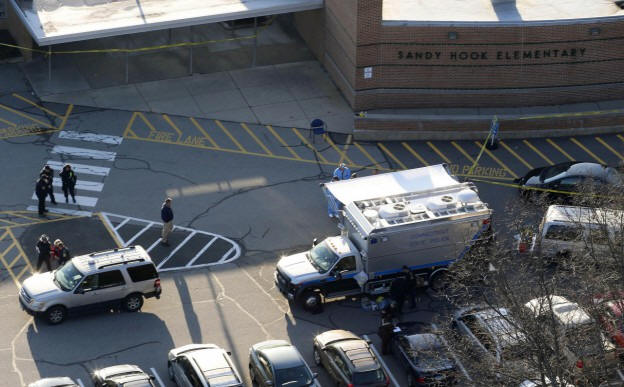 The large vehicle is the Mobile Command Center; Sandy Hook Elementary School 12/14/2012 (Associated Press /Julio Cortez) *************** More than two
hundred and sixty five people have been killed in multiple death armed
attacks since the Littleton, Colorado Columbine High School shootings in
1999 through the recent armed attack at the Sandy Hook Elementary
School in Newtown, Connecticut. |
An MCI may involve a variety
responders and agencies including: |
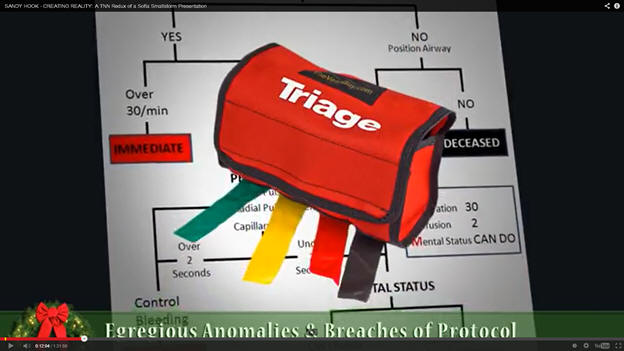 |
Video 2: Smallstorm talks about an MCI, a mass casualty incident, that she says uses Start Triage which she states in her video was developed in 1983 by Hoag Hospital and the Newport Beach, California Fire Department. First responders used it at two well-known incidents, the bombing of the World Trade Center and the Alfred P. Murrah Federal building. MCIs now use the NIMS in accordance with the established ICS, a model designed to expand as the incident develops. According to the Mass Casualty Care Committee, convened by the Connecticut EMS Advisory Board (November 16, 2005) the tagging of patients is usually completed in the first 10-15 minutes. Only one or two people are responsible for these assessments. Tagging is completed before the back-up responders are brought in from the staging area, which in this case was the Sandy Hook firehouse. |
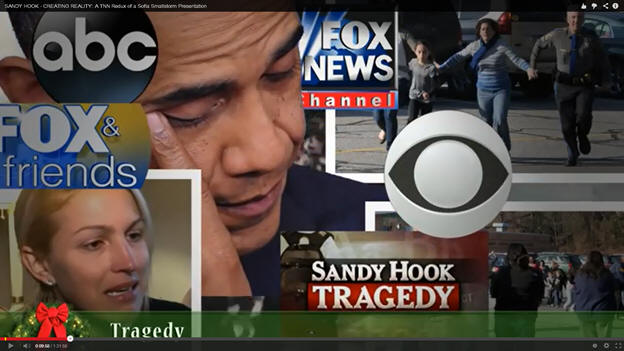 |
The North Central Connecticut EMS Council Management, located in
Hartford, developed
MCI Levels as well as
Level 2 MCI (21-50 victims) |
 The Staging Area for the Sandy Hook MCI was the firehouse (Julio Cortez, AP) |
Staging Areas: All
responding EMS units should go directly to the assigned STAGING AREA and
await further instructions. Do not leave the staging area until you are
instructed to do so by the
Medical
Branch Director/Medical Group Supervisor
or the direction of North Central
CMED. On page 20, it says, regarding the Ambulance Coordinator (AC) that
the AC reports to the
Patient Transportation Unit Leader, manages the ambulance staging
area(s), and dispatches ambulances as requested.
|
 |
The following information is from the
Aurora Fire Department's Preliminary Analysis and is similar to the
policies used at Sandy
Hook and is typical in all ICS events: Stage: A term used by responding apparatus to designate the need to stop the apparatus away from the scene in order for the first arriving unit or Incident Commander to determine the course of action needed. Incoming units may be directed to stage away while an investigation is conducted. Staging: This is a specific location where responding resources will report. Apparatus, crews and resources in the staging area are considered immediately deployable to the emergency scene. This allows the Incident Manager to efficiently assign units where they are most needed in an organized manner thus maintaining unit accountability and avoiding duplication of effort. With staging such an integral part of any large scene, organization of that area is critical. It was NOT, as people have suggested, evidence of egregious anomalies and breaches of protocol. |
|
On page 6 of the
North Central
Connecticut EMS Council Management manual it states: SMART triage:
|
On page 11 of the
North Central
Connecticut Emergency Medical Services (EMS) Council Management it says: |
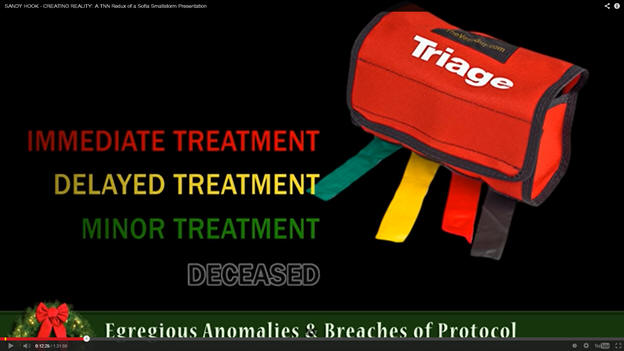 Video 2 image is above. She also has a similar image in Video 1, the one that she created. |
The following codes are from the
Aurora Fire Department's Preliminary Analysis and are similar to the
practices used at
Sandy Hook, including adjacent staging Code Green: This person has an injury but is walking without difficulty, able to follow commands, and has no immediate life threat. Code Yellow: This person is unable to walk due to injury. Patient is breathing adequately at a rate between 15 and 30 respirations per minute and there is a palpable pulse. (This patient needs to be treated at the hospital but will not die from the injuries sustained in the near future. Code Red: This person is breathing over 30 respirations per minute—or only starts breathing after repositioning the airway. This person may be breathing; however, there is no palpable radial pulse. This person may be unable to follow simple commands. Any of the above presentations categorizes this patient as a Red or immediate transport. Code Black: This Person has massive blunt head, chest or thoracic trauma. No breathing noted with a change in airway position. This person is categorized as deceased on the scene with no further treatment rendered. Smallstorm agrees that black means deceased but claims that everyone must be taken to the hospital to be pronounced dead. If no one at the crime scene can determine death, there would not be a triage category of "deceased." See Pronouncement of Death by a Registered Nurse. See also document #2113 here. |
 |
Video 2: Smallstorm quoted some un-namen person
from an Internet forum: “…the main sticking point is the EMS services
did not behave within their normal scope. A mass shooting would have
trauma helicopters flying children out one after another while
performing CPR the entire way to the hospital and patients would be
declared dead at the hospital after extensive measures were taken to try
to save lives. I've been in the ER for 5 years and we get ALL code blue
patients. We get 80-year old nursing home patients that have not been
breathing for 20 minutes with no chance of survival and we perform CPR
and necessary medical intervention with the chance that patients may
regain a pulse.” |
 |
Smallstorm admitted that Sandy Hook was an MCI – Start Triage is used at all MCIs. Start means Simple Triage and Rapid Treatment. She says that they did not use Start Triage at Sandy Hook. The few red and yellow tarps on the ground were empty and they did not bring any bodies out of the school. Of course not, twenty-four people were already dead and beyond the stage of triage in the yellow and red category. |
 |
In Video 1 and 2, Smallstorm said she talked to a couple of EMTs who told her that everyone uses Start Triage when there is an MCI. Further, she said they told her, "The police can’t pronounce people dead. We can’t pronounce anyone dead – unless they’re decapitated and it’s totally obvious. We have to take EVERYONE to the hospital. That’s where they pronounce them dead. The police don’t have the authority. WE don’t have the authority." Smallstorm says, according to her un-named sources, that "trauma helicopters" should have been flying children to the hospital. Again, if an EMT cannot pronounce someone dead on the scene, why do the medical practitioners, nationwide, use triage tags that employ the color black for DEAD if those medical practitioners are not allowed to declare anyone dead? Her "information" totally contradicts the policies set by North Central Connecticut EMS Council Management. EMTs handled the shootings at SHES according to the guidelines established in April 2007 by the Connecticut Department of Publish Health. |
 |
Page ten of the
Report of the State’s Attorney, stated that there were fifteen children
in classroom #8, fourteen were dead and they transported one child
from classroom #8 to
the Danbury Hospital, who they later pronounced
dead. Only one child survived from that classroom. They found five
children in classroom #10, four of whom were dead. They transported the
surviving child to the hospital, who was pronounced dead. They found
eighteen children and six staff members, all deceased, within the school
and two children who they pronounced dead at Danbury Hospital. Two other
staff members were injured and were treated at nearby hospitals and
survived. |
 This aerial photo was taken by Julio Cortez, AP |
Julio Cortez took the photo to the left showing the firehouse, the staging area. That image was featured in an article by Kristen V. Brown and Ana Ley, of News Times, For many, Sandy Hook school should be razed, published on 12/26/2012. A YouTuber apparently borrowed some footage from the 42-minute Sandy Hook Chopper 12 Footage: Sandy Hook Chopper 12 Footage. Someone extracted and looped a portion of that film, added music and variable video speeds to make it appear that people were aimlessly walking in circles and published it on January 30, 2013. Both Smallstorm and Klein used the first part of that video to "prove" that all of the people were "actors" and were simply milling around with nothing to do. Smallstorm observes that people were not interacting with each other. See the two images from their videos below. People can easily ascertain that it is a looped video. In Smallstorm's video at 54:12 -55:04, one will notice the silver van up in the left go by repeatedly. It seems incredible that Klein and Smallstorm, two experienced video makers, did not notice that the video is very obviously looped. |
 |
 Video 1: at 54:12 -55:04; watch this part and notice the silver van up in the left go by repeatedly; very obvious! |
| The creators of We Need to Talk About Sandy Hook perpetuate the idea that people were walking in circles. One can see the very same silver vehicle up in the left-hand corner of that video because they apparently used the same looped video. One may view the silver vehicle in the left-hand corner at 1:55:40-1:55:54 minutes. Are people supposed to believe that manipulated video footage are proof that no one died at Sandy Hook? | |
 One of David Dees fabulous creations found here, Dees designed the covers for my three books. |
Smallstorm introduces Agenda 21
that globalists developed during the Conference on Environment and
Development (UNCED) in Rio de Janeiro, June 3-14, 1992 and suggests that
many people had moved to Newtown for strategic reasons. She gives
us a few facts about Agenda 21 as if it somehow applied to the shootings
at SHES.
The first indication that a community is implementing
Agenda 21 is a membership in ICLEI
(International Council for Local Environmental Initiatives), or
ICMA (International
City/County Management Association). Newtown does not belong to either
group. Although Newtown has celebrated Earth Day for the last seven
years, it has not signed the Earth Charter. Given the many indications
that Agenda 21
is operating in a community, it seems very unlikely that Sandy Hook
embraced Agenda 21. Smallstorm provides some illustrations - a
300-pound man would likely break a chair made for a very small child, a
plastic fork cannot pierce a coconut and jet fuel fires could not melt
the steel frames of the twin towers, all undeniable facts. Then she
subtly speculated, “a
lightweight like Adam Lanza couldn’t shoot that many people in the time
frame and with the weapons he was said to be carrying,” strongly
suggesting that it was an undeniable fact, repeating Mark S. Mann's
claims.
|
 |
Earlier, at about eight minutes into
Video 1, Smallstorm
reminded people that the incident took place one week before the
solstice of the solstices, suggesting the idea of Satanic worship and
human sacrifice, thus inviting speculation and perhaps provoking others
to travel down that rabbit hole. At about twenty minutes into the
video, she introduces the Masonic element when she states that
three men ran from the school through the woods towards the Masonic
Lodge. Masonry, especially at its top levels, is indeed questionable and can addressed in context, but there is no indication that
masonry was a factor in the events at Sandy Hook. In a radio
interview she stated that there is a Church of Satan in Sandy Hook. She
talks about so many conflicting reports. Again, she said a light-weight 20-year
old youth cannot carry all of that equipment and “accurately and
consecutively shoot twenty-six people” and "A little target practice with mom does not produce
twenty-six victims
in five to seven minutes. |
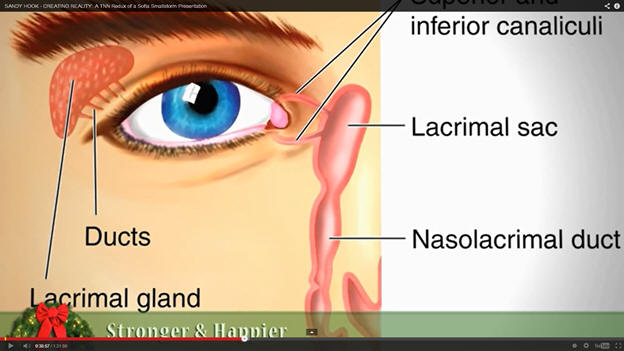 |
Smallstorm then shows a portion of Anderson Cooper's
interview of Chris and Lynn McDonnell |
 |
Why do some people shift all of this focus on the victims, including Nancy Lanza? They scrutinize their actions, what they were wearing when they arrived to pick up their children, inconsistencies in their hair and in photos. Who did the photo-shopping, if it was done and why? I look somewhat different in every picture that someone takes as do many people. Smallstorm, even questioned photos of Ryan and Adam Lanza. She questioned Ryan's purported hairstyle change. She suggested, without legitimate research, that there might have been only one Lanza son. Questioning photo possibilities might seem evidentiary to some people but it is insubstantial as proof of anything. Why are some seemingly sincere people questioning the actions or what they claim to be the anomalies of the first responders? Who or what entities would benefit by castigating, making accusations or projecting blame on the families and response agencies and claiming that this whole event was a drill? This appears to be a distraction; who is behind it and when did "they" initiate it? If this is damage control operation, it must involve billions of dollars to create so many distractions. |
 |
|
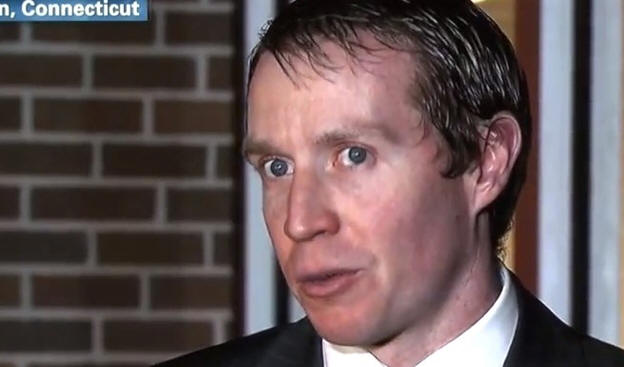 |
In Video 1, at about 23:00, Smallstorm claimed that the parents did not "act devastated enough." She said they were strangely complacent, even smiling, showing a whole new kind of grief after the death of their children. She claimed that "Skepticism rang loud and long all across the Internet. How could anyone believe that these parents had lost their six-year olds as they did not act devastated." Perhaps she and her fellow hoaxers were part of the early perception management that provoked skepticism. On 12/14/2013, one person in a video commented on the way that Parker acted prior in his press conference: "It's funny how he expresses that it is OKAY to laugh and to cry at the memory of someone who has passed! It is healthy to cope with grief and experience/express a multitude of emotions - not just happiness or sadness. You can hear that his voice is not very strong and that he seems to be holding back his sadness. I'm not sure what the "conspiracy" is here, that he had a part in killing his daughter? How awful that some people need to make an awful thing even worse by looking for faults in the survivors who are going through more than most could ever imagine, not just the loss of his daughter, but the PUBLIC loss of his daughter and someone whose grief is being analyzed by millions of people!" |
| These were happier times. Is someone going to claim that this image is photo-shopped in anticipation of 12/14/2012? Did this good family, who some claim are actors, pretend to have a family just for what some individuals would later call a FEMA drill? | |
 |
Again, putting the distracting focus on the families,
Smallstorm, evidently lacking research skills, said that she could not find evidence that Robbie Parker was
a physician's assistant. However, here is evidence of his occupation:
Robbie Parker's License
|
| Smallstorm's Standards of Sadness | |
 |
The Beslan school hostage crisis (also referred
to as the Beslan school siege or Beslan massacre) started September 1,
2004, the first day of the school year, and lasted three days and
involved the capture of over 1,100 people as hostages (including 777
children). The 3-day event resulted in the deaths of over 380 people.
The crisis began when a group of armed Islamic separatist militants,
mostly Ingush and Chechen, occupied School Number One in the town of
Beslan, North Ossetia (an autonomous republic in the North Caucasus
region of the Russian Federation). Initially, officials
reported that 396 people, mostly hostages, were killed during the
crisis. By September 7, 2004, Russian officials revised the number of
deaths to 334, including 156 children, although close to 200 people
remained missing or unidentified. Locals claimed that over 200 of those
that terrorists killed had burn marks while more than 100 were burned
alive. |
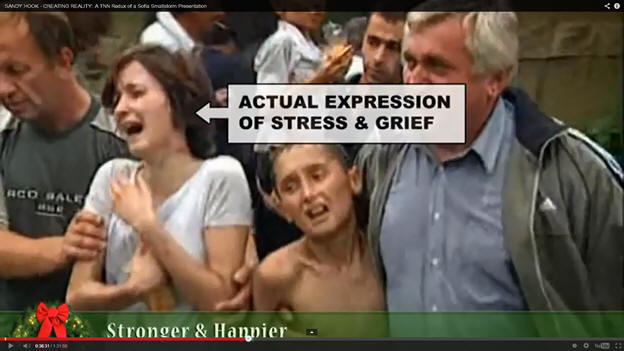 |
School shootings in the United States 38
school shootings in the 1990s In three decades, there were 164 separate school shootings in the United States, each of which produced dead bodies. Not included in that number was the Virginia Tech Massacre on April 16, 2007, during which Seung-Hui Cho allegedly shot and killed 33 people, 5 faculty members and 27 students before shooting himself in the head. Yet, video-maker Peter Klein, endorsed by Smallstorm, apparently resorted to another country, Russia, in order to show dead bodies and victims being rescued from a school. Could it be that the American population has sensitivities and laws that prevent the media from showing such scenes? |
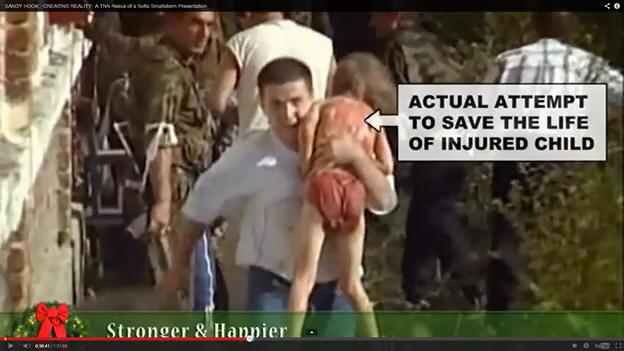 |
Klein and Smallstorm wish to demonstrate what they consider normal behavior during and following a school shooting. Yet, they evidently could not find examples in the United States, despite the dozens of mass school shootings, that show what they consider appropriate actions when evaluating first responder protocols, human reactions to the loss of a child or family member, or crime scene photos. |
 |
Maybe it is just me but I do not see any real tears streaming down this man's face. I recognize that the text says, Actual parent exhibiting signs of grief & loss. How does Klein even know if this was an actual parent, the father of one of the children who may have been killed out of the 1,100 people who were held as hostages. Klein tells us that 380 died but we do not know how many of them were children. |
 |
I am really not interested in seeing dead bodies as
proof that someone died. Despite the hundreds of people in
America who die in car and other kinds of accidents or who are murdered,
the media does not publish the images. There are
laws in
each state that determine what the public is shown. We are so used to seeing
violence, killing, blood and death on television that some people feel
entitled to see the same kind of violence in the news. Smallstorm,
Fetzer and others claim that the victim's families did not display any
sadness. The pictures below show otherwise. |
 Child actor? I don't think so! |
 |
 |
 Source |
 Source |
 Source |
 Source |
 Source |
|
|
 |
|
|
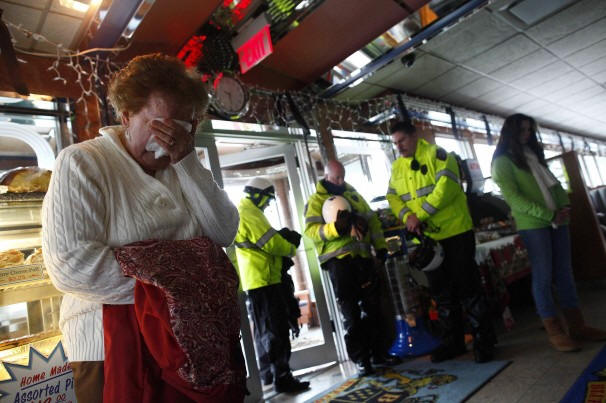 |
| Part 3 |